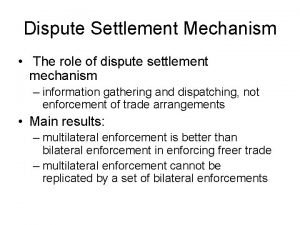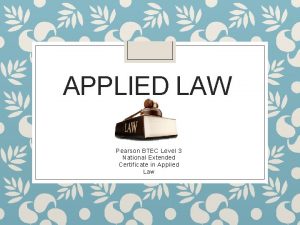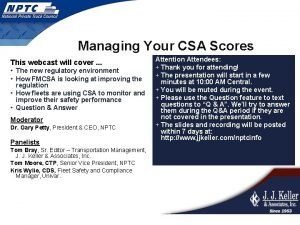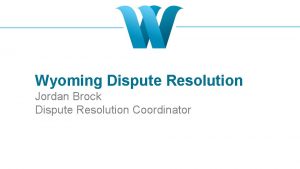Alternative Dispute Resolution Alternative dispute resolution is a







- Slides: 7

Alternative Dispute Resolution Alternative dispute resolution is a way to settle disagreements other than using a lawyer and going to court. Three most common forms of Alternative Dispute Resolution are: 1. Negotiation 2. Arbitration 3. Mediation ================ 1. Negotiation A process whereby both parties communicate to reach a mutually acceptable agreement For example: You hit someone's car in the parking lot and you both decide that you will pay for the other person's repairs as long as they get three different quotes from mechanics and choose the cheapest one.

Note***Negotiation can be used to settle disagreements ranging from minor disputes between siblings to multi-billion dollar lawsuits between large corporations.

2. Arbitration A process in which a neutral third party hears both sides of the dispute and makes a binding decision For example: Often used in labour disputes between unions and companies. The arbitrator is legislated and their decision is usually binding. They are usually experts in their field of law and in the industry. The Arbitrator is like a judge, but the process is less formal than a trial. i) Arbitrators have the authority to make the final decision and the parties must follow it if it is “binding arbitration. ” If it is “nonbinding arbitration, ” the parties are not “bound” and hence do not have to follow the final decision. ii) Arbitration is common in contract and labour management disputes. 1. Many sales and service agreements have an “arbitration clause” requiring “binding arbitration. ”

3. Mediation A process in which a neutral third party (a mediator) intervenes to bring opposing parties to an agreement Example: You and your neighbour are disagreeing over who has to pay the repairs on a mutual fence that divides both your properties. Instead of taking it to court, a mediator is assigned to your case and sits down with both of you to work out a fair agreement. The mediator cannot force you to settle the dispute or accept a solution. If things don't work out you may still go to court.

Mediation Benefits of Mediation A) Voluntary i) The parties decide whether they want to come to the mediation ii) The parties decide how they want to resolve the dispute. iii) Mediators do not impose a decision on the parties. iv) Mediators instead listen carefully to both parties, try to help them understand each other’s position, and find ways to resolve the dispute. v) The parties are free to leave at any time B) Confidential i. Canadian law makes mediation sessions confidential. ii. Parties can talk without worrying about hearing it later in court. iii. Mediator cannot be called to testify in court as a witness for a party’s case. C) Effective i. Allows disputing parties to vent their frustrations. ii. Avoids placing blame and concentrates on the future relationship between the parties. iii. Allows parties to come up with creative solutions that are not available through the court system (e. g. periodic payments)

iv. Because the solution is created by the parties, the parties are more interested in making it work and more willing to live up to it. D) Enforceable i) If a settlement is reached, it can be written as legally binding contract. 1. Note that written agreements are almost always more effective than oral agreements. ii) If it is not written down, the agreement is not legally binding. E) Free i) Many community mediation programs offer free mediation (the University of Toronto Law School Mediation Clinic). ii) Mediation is a common way to resolve disputes between couples, landlords and tenants, and consumers and businesses. iii) Some schools train students to mediate disputes between students that occur at school.

Activity In groups of three choose one of the situations. Choose one person to be the plaintiff and one person to be the defendant. The third person will be the mediator. Try to resolve this issue so that it is mutually acceptable and you do not have to go to court. Use the “Steps of Mediation” to complete the task. 1. Sarah and Shelley went to Super. Sonic, an electronics store, to purchase a DVD player. As they were leaving the store, Shelley tripped on the corner of the carpet that had not been properly secured, and she fractured her ankle. Because Shelley was unable to work as a snowboard instructor during peak season, she lost income for six weeks. 2. Mr. and Mrs. Graham are divorced. Mr. Graham has custody of their three children. Because his job requires that he stay out of town overnight during the week, he has to hire a live-in caretaker. Mrs. Graham had agreed to share this expense as part of her support payments. Mrs. Graham has since stopped making her support payments to Mr. Graham. 3. Mandy had contracted with Big Top Roofers to replace the roof of her 30 -year-old house. After she paid for the job, she discovered that the quality of the singles used was inferior to the quality specified in the contract.













